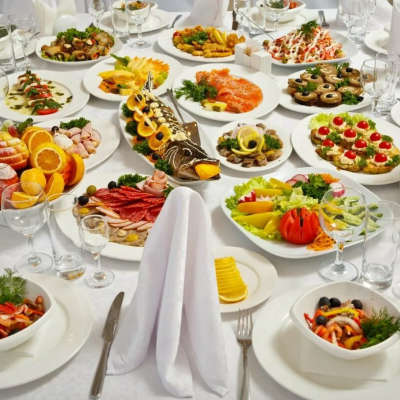Global Culinary Trends of 2024: What's New in World Cuisine?
Discover how technology, sustainability, intercultural interactions, and the demand for authenticity are shaping the global culinary trends of 2024 and defining the future of gastronomy.
19 April 2024
Introduction to Global Culinary Trends
Technological Innovations in Culinary Arts
Sustainability and Eco-Friendly Practices in Food
Returning to Roots: Authenticity and National Cuisines
Experiments with Vegan and Vegetarian Cuisine
Fusion Cuisine: Blending Cultural Flavors
Popularity of Street Food and Food Trucks
Interactive Cooking Experience
The Influence of Social Media on Culinary Trends
Forecasting the Future of World Cuisine

Introduction to Global Culinary Trends
In the modern world, cuisine is more than just cooking food. It is an art, a science, and a means of cultural communication. Today, we embark on an exciting journey through the global culinary trends of 2024 to understand the prevailing tastes, technologies, and concepts in the culinary world.
Global culinary trends are constantly evolving. They reflect changing consumer preferences, new technologies, and societal trends. This is why we see the emergence of unique concepts and innovative approaches to food preparation.
One of the key trends today is the increasing role of technology in cuisine. From the development of new kitchen gadgets to the use of artificial intelligence in recipes, technology is changing how we cook and the ingredients we use.
Alongside technological changes, we also observe a growing interest in sustainable dining. Consumers are becoming more conscious of their environmental impact and care about the origin, quality, and health effects of the products they consume.
Equally important is the return to roots. Many chefs draw inspiration from the traditional cuisines of various cultures, giving their dishes an authentic taste and aroma. This trend allows us to immerse ourselves in the richness of cultural diversity through food.
Vegan and vegetarian cuisine also remain in the spotlight. Each year, the number of people opting out of meat and animal products increases, prompting chefs to create new tasty and nutritious alternatives.
Fusion cuisine continues to attract attention with its bold combinations of different culinary traditions. This provides an opportunity to try something new by blending tastes and textures from different cultures into one dish.
Street food is an integral part of modern cuisine. This trend highlights people's desire to enjoy delicious food in a casual setting, whether on the street or at a market.
The interactive cooking experience is becoming increasingly popular. It allows restaurant guests or cooking show participants to actively participate in the food preparation process, making it more engaging and memorable.
Social media continues to have a significant influence on culinary trends. Platforms like Instagram, YouTube, and others inspire chefs to create visually appealing dishes capable of capturing millions of hearts and stomachs.
This is just a glimpse of what we can expect from global cuisine in 2024. The future is filled with delicious discoveries and amazing innovations.
Technological Innovations in Culinary Arts
Technological innovations are permeating every aspect of culinary arts, from the cooking process to guest service. In today's world, chefs utilize a wide range of devices and applications to enhance the quality and efficiency of their work.
One of the most significant achievements in culinary technology is the use of artificial intelligence. It is used to develop innovative recipes, predict demand for dishes, and even optimize the production process.
3D food printing is another exciting trend that is revolutionizing the way dishes are presented. This technology allows chefs to create unique shapes and textures, opening up new possibilities for culinary creativity.
Virtual reality has also found its application in the culinary world. It is used to create unique training programs that allow chefs to immerse themselves in a virtual environment and practice preparing complex dishes.
Unmanned delivery drones and helper robots are becoming increasingly common in the restaurant business. They facilitate the food delivery process and automate routine tasks in the kitchen, freeing up time for the chef for more creative activities.
Interactive kitchen appliances and devices are also keeping up with the trends. They provide chefs with the opportunity to experiment with different cooking techniques and create more interesting and delicious dishes.
With the development of the Internet of Things, kitchen appliances are becoming smarter and more automated. They can regulate temperature, cooking time, and even order necessary ingredients autonomously.
Mobile applications for chefs offer a wide range of functions, from inventory management and menu planning to ordering ingredients and receiving feedback from guests.
Blockchain technologies are beginning to penetrate the culinary sphere. They provide transparency and reliability in the food supply chain, allowing consumers to be confident in the quality and origin of products.
With the advancement of technology in the culinary arts, new opportunities are opening up for chefs to bring their culinary fantasies to life and surprise guests with unique dishes.
Sustainability and Eco-Friendly Practices in Food
In the modern world, sustainability and eco-friendliness in food are becoming increasingly important aspects for chefs and consumers alike. This trend reflects a growing awareness of the impact of our diets on the environment and human health.
One key aspect of sustainable eating is the use of local and seasonal produce. This helps reduce the distance food travels, minimize carbon emissions, and support local producers.
Vegetarian and vegan cuisine also contribute to sustainability in food. These diets require fewer resources such as water and land for food production and reduce the negative environmental impact of animal agriculture.
Many chefs are actively implementing zero-waste practices in their kitchens. This includes reducing the use of single-use packaging, recycling food scraps, and utilizing the whole product, including skins and bones.
Organic products also play an important role in sustainable eating. They are produced without the use of chemical fertilizers and pesticides, making them more environmentally friendly and safer for health.
Reducing meat and fish consumption also contributes to sustainability in food. Chefs are increasingly incorporating plant-based meat and fish alternatives into their menus, using proteins such as soy, peas, and mushrooms.
Minimizing the use of packaging and plastic is also becoming an important aspect of eco-friendly eating. Chefs and restaurants are increasingly switching to biodegradable packaging and tableware to reduce their environmental footprint.
Organic waste recycling systems in kitchens are becoming more common. They help reduce waste volume and give a second life to products that would otherwise be discarded.
Promoting principles of sustainable eating not only contributes to environmental care but can also be an important marketing tool for restaurants. Consumers increasingly value the ethics and sustainability of brands, which can lead to an expanded customer base.
Developing sustainable practices in food is not just a matter of fashion but an integral part of a responsible approach to culinary arts in the modern world.
Returning to Roots: Authenticity and National Cuisines
Returning to roots and seeking authenticity are becoming increasingly noticeable trends in global cuisine. Chefs are exploring traditional recipes and cooking methods to recreate the taste and atmosphere of national cuisines.
Authenticity is a keyword in contemporary gastronomy. As people travel the world in search of new experiences, they increasingly seek to taste genuine dishes prepared according to traditional recipes and using local ingredients.
National cuisines have become objects of study and inspiration for many chefs. They learn unique cooking techniques and specific ingredients that make each cuisine unique and distinct.
Preparing national dishes using authentic ingredients allows chefs to convey the authentic taste and atmosphere of a particular culture. This creates an opportunity for restaurant guests or festival visitors to immerse themselves in the culture and traditions of other countries and peoples.
Often, returning to roots involves not only recipes but also the ambiance and presentation of dishes. Chefs strive to create an authentic atmosphere that maximally conveys the spirit and style of a particular cuisine.
Restaurants specializing in specific national cuisines are becoming increasingly popular among connoisseurs of authentic food. This opens up new opportunities for chefs to experiment with different culinary traditions.
Preserving and transmitting the heritage of culinary traditions is an important task for many cultures. Chefs play a key role in this process, preserving and respecting ancient recipes and cooking techniques.
Returning to roots also includes using seasonal and local ingredients, which form the basis of many traditional dishes. This not only contributes to environmental balance but also supports local producers.
The emotional component plays an important role in consuming national dishes. Chefs strive not only to satisfy the guests' taste preferences but also to convey to them a piece of cultural heritage through food.
Returning to roots in global cuisine opens up new horizons for chefs, inspiring them to create dishes that are not only delicious but also uniquely reflect the cultural heritage of different peoples.
Experiments with Vegan and Vegetarian Cuisine
Vegan and vegetarian cuisines are becoming increasingly popular in the world of gastronomy, opening new horizons for chefs and bringing pleasure not only to vegans and vegetarians but also to those who simply want to try something new and delicious.
One of the key features of vegan and vegetarian cuisine is the creative use of plant-based ingredients instead of meat and dairy products. Chefs explore a wide range of vegetables, legumes, mushrooms, and grains to create dishes that are not only tasty but also nutritious.
Experimenting with alternative sources of protein is becoming a priority for chefs. They use soy products, tofu, seitan, quinoa, and other plant-based protein sources to give their dishes rich flavor and texture.
Vegan and vegetarian cuisines offer a huge variety of dishes, from classic salads and soups to exotic culinary experiments. Chefs find inspiration in various cultures and traditions to create unique flavor combinations and aromas.
One of the key trends in vegan and vegetarian cuisine is the use of local and seasonal ingredients. This not only helps maintain environmental balance but also gives dishes a special taste and authenticity.
Vegan and vegetarian cuisines are becoming increasingly accessible and in demand not only in restaurants but also at home. Chefs share their recipes and cooking secrets on various culinary platforms and social networks.
Creative use of spices, herbs, and sauces plays an important role in vegan and vegetarian cuisine. They help give dishes a rich flavor and aroma, making them irresistibly appetizing.
Experimenting with texture is also an important aspect of creating vegan and vegetarian dishes. Chefs use various cooking methods to achieve the desired consistency and surprise guests with unique textures.
The development of vegan and vegetarian cuisine opens up new perspectives for chefs, inspiring them to constantly innovate and create in the culinary world.
Fusion Cuisine: Blending Cultural Flavors
Fusion cuisine is a unique phenomenon in the world of gastronomy, blending elements of different culinary traditions and cultural flavors. Chefs practicing fusion cuisine strive to create dishes that combine the best features of different culinary styles and cultural traditions.
The main principle of fusion cuisine is the fusion of various culinary traditions and ingredients in one dish. This allows chefs to create amazing flavor combinations and textures that satisfy even the most discerning gastronomic tastes.
Fusion cuisine opens up new horizons for chefs, allowing them to experiment with different culinary techniques and ingredients. They can use elements from Japanese, Italian, Mexican, and other cuisines to create unique and memorable dishes.
One of the key advantages of fusion cuisine is the opportunity to bring new experiences and perspectives to traditional culinary recipes. Chefs can add unexpected ingredients or spices to give old dishes a fresh and modern taste.
Fusion cuisine also promotes cultural exchange and understanding. Travelers can try dishes that combine influences from different cultures, helping them better understand and appreciate the diversity of culinary traditions.
Chefs practicing fusion cuisine must have extensive culinary experience and creative thinking. They should be prepared for unconventional approaches to cooking and be open to new ideas and inspiration.
However, it is important to remember that fusion cuisine requires balance and harmony between different flavors and textures. Chefs must skillfully combine ingredients to create dishes that are not only delicious but also aesthetically appealing.
Fusion cuisine represents a constant creative journey for chefs. It allows them to explore new possibilities and express their individuality through food.
This culinary style is suitable for those who appreciate experimentation and seek to discover new taste sensations. Fusion cuisine is a celebration of imagination and taste that never ceases to amaze and inspire.
Popularity of Street Food and Food Trucks
Street food and food trucks are becoming increasingly popular in global cuisine, attracting both locals and tourists with their authenticity, variety, and accessibility. This culinary trend brings the taste and atmosphere of street markets right onto the city streets.
One of the main features of street food is its diversity. At street markets and festivals, one can find dishes from almost any cuisine in the world: from Mexican tacos to Japanese ramen and Mediterranean kebabs.
Street food is characterized by its simplicity and quick preparation. Chefs specializing in street food often use minimal ingredients to create dishes that can be served on the go without sacrificing quality and taste.
Street food offers the opportunity to enjoy authentic flavors and aromas without the need to visit a restaurant. This makes it particularly appealing to those who appreciate the street atmosphere and casual dining experience.
One of the key advantages of street food is its affordability. Prices for street food are usually lower than in restaurants, making it attractive to a wide audience, including students, tourists, and locals.
Street food is also a wonderful way to experience the culture and traditions of the local population. At street markets, you can try dishes that are true culinary treasures of the region.
Chefs specializing in street food are often inspired by traditional recipes and cooking methods to create unique flavor combinations that will delight even the most discerning gourmets.
Street food stimulates culinary diversity and innovation. Chefs constantly experiment with new ingredients and cooking techniques to surprise guests with their original dishes.
This culinary trend opens up new opportunities for entrepreneurs and chefs, allowing them to create successful businesses based on mobile culinary points and street cafes.
Street food continues to win the hearts of food enthusiasts around the world, offering them the opportunity to enjoy authentic flavors and the atmosphere of street markets right on their own streets.
Interactive Cooking Experience
The interactive cooking experience is a unique way to immerse oneself in the world of culinary arts, combining educational, entertaining, and gastronomic aspects. Chefs offer guests not only the opportunity to enjoy delicious dishes but also to actively participate in the cooking process.
One of the main principles of the interactive experience is the opportunity for guests to create their own dishes. Chefs provide ingredients, recipes, and instructions, allowing each participant to independently prepare their unique dinner or lunch.
The interactive cooking experience promotes team spirit and collaboration. Guests can work in pairs or small groups to overcome culinary challenges together and achieve a common goal.
For chefs, the interactive experience provides a unique opportunity to interact with guests, share their knowledge and expertise, and observe their reaction to the cooking process and the taste of the dishes.
This type of gastronomic experience also contributes to the education and development of culinary skills among guests. They can learn new recipes, master cooking techniques, and experiment with different ingredients under the guidance of experienced chefs.
The interactive cooking experience can be organized in restaurant settings, culinary workshops, or festivals. This makes it accessible to a wide audience and allows everyone to find the optimal format for participation.
The main focus in the interactive experience is not only on cooking dishes but also on their presentation and serving. Chefs assist guests in creating beautiful and appetizing dishes that please not only the taste buds but also the eyes.
The interactive cooking experience stimulates creative thinking and imagination. Guests can experiment with different combinations of ingredients and spices, creating their own unique recipes.
This type of culinary entertainment also allows guests to enjoy the process of cooking food, not just consuming it. This contributes to the formation of new culinary interests and hobbies.
The interactive cooking experience is not just a way to enjoy delicious food but also to create unforgettable memories that will accompany guests for a long time.
The Influence of Social Media on Culinary Trends
Social media have a significant impact on culinary trends, playing a key role in shaping the tastes and preferences of modern food enthusiasts. Platforms such as Instagram, YouTube, and Pinterest have become integral parts of many people's lives, offering them an endless stream of inspiration and ideas for culinary experiments.
One of the primary ways social media influences culinary trends is by popularizing specific products and ingredients. Photos and videos of delicious dishes and unique ingredients can quickly go viral, attracting the attention of millions of users and creating demand for these products.
Culinary bloggers and influencers play an important role in shaping culinary trends through social media. Their recipes, tips, and recommendations have a significant influence on consumer behavior and preferences, helping them discover new flavors and experiment with culinary techniques.
Social media also contribute to the globalization of culinary trends, allowing users from different countries and cultures to exchange experiences and inspire each other. This creates a unique opportunity for cross-cultural exchange of culinary ideas and traditions.
One of the key aspects of social media's influence on culinary trends is the creation of visually appealing content. Photos and videos of beautifully presented dishes can stimulate appetite and desire to try something new, encouraging users to experiment in the kitchen.
The popularity of certain culinary trends often depends on their viral spread on social media. Trendy recipes and ideas can quickly become popular thanks to widespread sharing by users, leading to their rapid dissemination worldwide.
Social media also open up new opportunities for culinary entrepreneurs, allowing them to promote their products and services through visual content platforms. As a result, many small food businesses gain wide visibility and access to new customers.
However, it is important to remember that social media can sometimes distort reality, creating idealized images of the culinary world. Users should be critical and remember that behind beautiful photos may not always lie real recipes and flavors.
Overall, social media play an undeniable role in shaping modern culinary trends, offering users not only inspiration and ideas but also new opportunities for kitchen experiments.
Forecasting the Future of World Cuisine
Predicting the future development of world cuisine is a complex task, requiring analysis of current trends and anticipating their potential impact on future gastronomic movements. In the future, we can expect even greater diversity and innovation in global cuisine, reflecting changing consumer needs and preferences.
On one hand, it can be speculated that there will be even more emphasis on healthy eating and sustainability in the future. Consumers are increasingly aware of the importance of a healthy lifestyle, which may lead to the increased popularity of vegan, vegetarian, and functional foods. Chefs will strive to create dishes that are not only delicious but also beneficial to health, using fresh and natural ingredients.
On the other hand, further globalization in cuisine can be expected. Connections between different cultures and countries will continue to strengthen, leading to further fusion of culinary traditions and the creation of new, unique flavor combinations. This may lead to increased popularity of fusion cuisine and other forms of culinary synthesis.
Technological innovations will also have a significant impact on the future development of cuisine. The possibilities of 3D-printed food, the use of artificial intelligence in the culinary process, and the development of synthetic food products will open up new horizons for chefs and allow them to experiment with new textures, shapes, and flavors.
However, along with technological progress, there may arise ethical and social questions related to the use of artificial products and cooking methods. Chefs will face the challenge of balancing innovation and tradition, preserving important aspects of cultural heritage and culinary tradition.
In the future, we can also expect a further increase in the popularity of culinary shows and events. Television shows about cooking, food festivals, and culinary tours will continue to attract the attention of a wide audience and stimulate interest in the diversity of world cuisine.
Another important direction for the future development of cuisine may be increased attention to sustainability and environmental friendliness in the production and consumption of food. Chefs and restaurants will strive to minimize their environmental footprint and use sustainable methods of food preparation and presentation.
Overall, the future of world cuisine presents an exciting and dynamic path, full of opportunities and challenges. Chefs will continue to play a key role in this process, inspiring and impressing us with new culinary discoveries and innovations.




